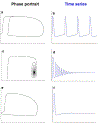Mathematical modeling of circadian rhythms
- PMID: 30328684
- PMCID: PMC6375788
- DOI: 10.1002/wsbm.1439
Mathematical modeling of circadian rhythms
Abstract
Circadian rhythms are endogenous ~24-hr oscillations usually entrained to daily environmental cycles of light/dark. Many biological processes and physiological functions including mammalian body temperature, the cell cycle, sleep/wake cycles, neurobehavioral performance, and a wide range of diseases including metabolic, cardiovascular, and psychiatric disorders are impacted by these rhythms. Circadian clocks are present within individual cells and at tissue and organismal levels as emergent properties from the interaction of cellular oscillators. Mathematical models of circadian rhythms have been proposed to provide a better understanding of and to predict aspects of this complex physiological system. These models can be used to: (a) manipulate the system in silico with specificity that cannot be easily achieved using in vivo and in vitro experimental methods and at lower cost, (b) resolve apparently contradictory empirical results, (c) generate hypotheses, (d) design new experiments, and (e) to design interventions for altering circadian rhythms. Mathematical models differ in structure, the underlying assumptions, the number of parameters and variables, and constraints on variables. Models representing circadian rhythms at different physiologic scales and in different species are reviewed to promote understanding of these models and facilitate their use. This article is categorized under: Physiology > Mammalian Physiology in Health and Disease Models of Systems Properties and Processes > Organ, Tissue, and Physiological Models.
Keywords: biological oscillators; circadian clock; circadian rhythms; dynamic systems; mathematical modeling; statistical modeling.
© 2018 Wiley Periodicals, Inc.
Conflict of interest statement
Conflicts of interest (past 2 years): Consulting: Pfizer Pharmaceuticals; Travel support: Sleep Research Society
Figures



References
-
- Abbott SM, Reid KJ & Zee PC (2015) Circadian Rhythm Sleep-Wake Disorders. The Psychiatric Clinics of North America 38:805–823. - PubMed
-
- Abel JH, Widmer LA, St. John PC, Stelling J, & Doyle FJ (2015). A Coupled Stochastic Model Explains Differences in Cry Knockout Behavior. IEEE Life Sciences Letters, 1(1), 3–6. doi: 10.1109/LLS.2015.2439498 - DOI
-
- Achermann P, & Kunz H (1999). Modeling circadian rhythm generation in the suprachiasmatic nucleus with locally coupled self-sustained oscillators: Phase shifts and phase response curves. Journal of Biological Rhythms, 14(6), 460–468. - PubMed
Publication types
MeSH terms
Substances
Grants and funding
- R01 HL128538/HL/NHLBI NIH HHS/United States
- R01-HL114088/NH/NIH HHS/United States
- K24 HL105664/HL/NHLBI NIH HHS/United States
- K24-HL105664/NH/NIH HHS/United States
- P01-AG09975/NH/NIH HHS/United States
- R01 HL114088/HL/NHLBI NIH HHS/United States
- P01 AG009975/AG/NIA NIH HHS/United States
- U01-HL111478/NH/NIH HHS/United States
- U01 HL111478/HL/NHLBI NIH HHS/United States
- R21-HD086392/NH/NIH HHS/United States
- R01-HL128538/NH/NIH HHS/United States
- R01 GM105018/GM/NIGMS NIH HHS/United States
- R01-GM105018/NH/NIH HHS/United States
- R21 HD086392/HD/NICHD NIH HHS/United States
LinkOut - more resources
Full Text Sources

